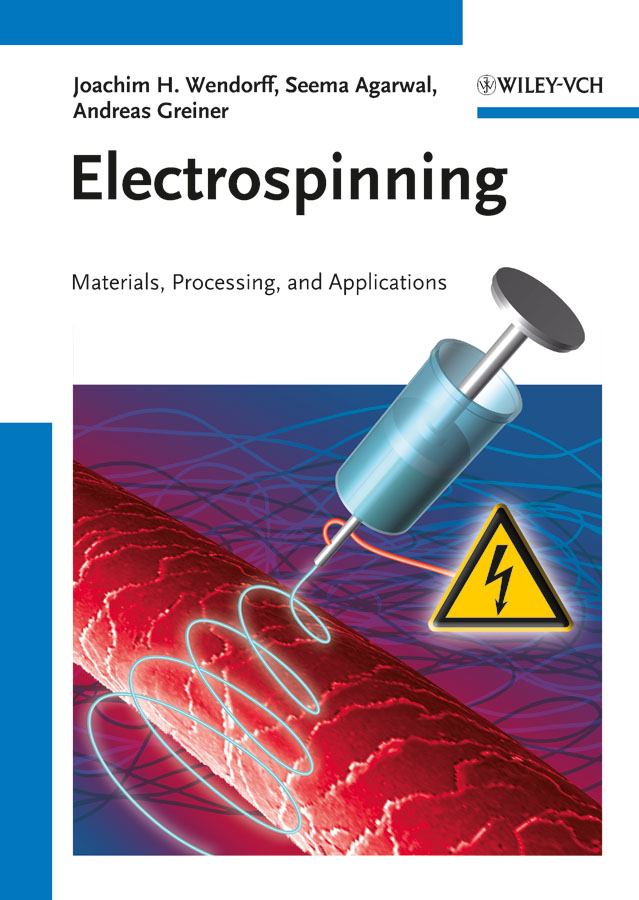
Electrospinning: materials, processing, and applications
Wendorff, Joachim H.
Agarwal, Seema
Greiner, Andreas
Bringing together the world's experts in the field, this book summarizes the state-of-the art in electrospinning with detailed coverage of the various techniques, material systems, and their resulting fiber structures and properties,theoretical aspects, and applications. Throughout the book, the current status of knowledge is introduced with a critical view on accomplishments and novelpersepectives. An experimental section gives hands-on guidance to beginners and experts alike. INDICE: Preface IX1 Introduction 11.1 Fibers - Key Functional Elements in Technology and Nature 11.2 Some Background Information 41.2.1 Structure of Crystalline and Amorphous Materials 41.2.2 Chain Conformation and Structures of Polymer Materials 71.3 Processing of Polymer Materials towards Fibers - Fiber Extrusion 101.4 Routes to More Advanced Fibers - Mimicking Nature 121.5 Electrospinning 161.5.1 A Simple Experimental Approach 161.5.2 The Hidden Physical Complexity 201.5.3 Short History of Electrospinning - The Routes Go Back More Than Two Centuries 221.6 Electrospinning - Important Facts to Remember 24References 262 Nature of the Electrospinning Process - Experimental Observations and Theoretical Analysis 292.1 Experimental Setups 292.2 Experimental Observationson Fiber Formation 332.2.1 Droplet Formation at the Tip of the Die 342.2.2 The Straight Path of the Jet 362.2.3 The Looping Part of the Jet - Onset of Bending Instabilities 402.2.4 The Deposition Process 422.3 Theoretical Analysis ofthe Nature of the Electrospinning Processes 452.3.1 Droplet Deformation and Onset of Jetting 462.3.2 Linear Path of the Jet 522.3.3 The Path of the Jet Submitted to Bending 552.3.4 Deposition on a Substrate 592.3.5 Onset of Further Instabilities 602.3.6 Branching Processes 662.4 Nature of the Electrospinning Process - Important Facts to Remember 66References 673 Nanofiber Properties 693.1 Parameters Controlling Nanofi ber Formation 693.2 Short Account on Methods of Analysis for the Structure of Electrospun Nanofibers 723.2.1 Analysis of Fiber Geometry and Topology 723.2.2 Analysis of the Internal Fiber Morphology 763.3 Control of Nanofiber Diameters 783.3.1 The Feeding Rate 783.3.2 Concentration of Polymer Spinning Solution 803.3.3 Electrical Parameters: Applied Voltage, Electrode Distance, Conductivity 833.3.4 Additional Factors 843.3.5 Mixtures of Solvents/Nonsolvents 843.4 Shape of the Fibers 843.5 Nanofi ber Topologies, Porous Fibers 883.6 Nanofi ber Trajectories in the Deposition Plane 923.7 Internal Morphology of Electrospun Nanofibers 963.7.1 Amorphous Polymers 973.7.2 Partial Crystalline Nanofi bers 993.8 Mechanical Properties of Single Nanofibers 1013.9 Nanofiber Properties - Important Facts to Remember 103References 1034 Nonwovens Composed of Electrospun Nanofibers 1054.1 Nanofiber Nonwovens - Functional Elements for Technical Applications 1054.2 Methods of Analysis for Properties on Nonwovens 1064.2.1 Nonwoven Architecture and Total Porosity 1064.2.2 Analysis of Pore Sizes 1074.2.3 Internal Specific Surface and Permeation Coefficient 1084.2.4 Permeation Coefficient 1094.3 Fiber Arrangements in Nonwovens 1094.4 Heterogeneous Nonwovens 1124.5 Porosity and Pore Structures - Theoretical Modeling and Experimental Analysis 1134.5.1 Prediction of Monte Carlo Simulations 1144.5.2 Experimental Results 1174.5.3 Nonwoven with Unimodal Fiber Diameter Distribution 1174.5.4 Comparisons of Experimental Results with Theoretical Predictions 1224.6 Mechanical Properties of Nonwovens 1244.7 NonwovensComposed of Electrospun Nanofibers - Important Facts to Remember 125References 1265 Electrospinning - Some Technical Aspects 1275.1 Technical Setups for Creating Jets 1275.1.1 Some Technical Details 1295.1.1.1 The Die 1295.1.2 High-Voltage Supply 1305.1.3 Counterelectrode 1315.1.4 Spinning Chamber 1315.1.5 Multiple-Die Setups 1325.1.6 Die-Free Multiple-Jet Injection 1335.2 Designs of Counterelectrode Confi gurations Allowing Preparation of Nonwovens with a Broad Range of Architecture 1375.3 Electrospinning - Some Technical Aspects - Important Facts to Remember 141References 1426 Modification of the Electrospinning Technique 1436.1 Towards Advanced Modes of Fiber Preparation and Deposition 1436.2 Near-Field Electrospinning - High-Precision Deposition Electrospinning 1446.2.1 Deposition of Individual Fibers 1486.2.2 Deposition of Nonwoven Test Pattern 1516.2.3 Deposition of Precision Nonwovens Paths 1516.3 Towards Core-Shell and Hollow Fibers 1556.3.1 Coelectrospinning/Coaxial Electrospinning 1556.3.2 Core-Shell Fibers and Hollow Fibers via a Template (TUFT Approach) 1606.3.3 Background Information 1606.4 Modification of the Electrospinning Technique - Important Facts to Remember 162References 1637 Materials Considerations 1657.1Introduction 1657.1.1 Background Information 1667.1.1.1 Solutions and Dispersions 1667.1.1.2 Bioerodible and Biostable Polymers 1667.2 Spinning from Organic Solvents 1667.3 Spinning of Water-Soluble Polymers 1707.4 Spinning of Biopolymers 1727.5 Spinning of Complex Polymer Systems 1757.5.1 Background Information 1757.6 Nanofi bers from Polymer Hybrids, Metals, Oxides 1787.7 Melt Spinning 1807.8 Materials Considerations - Important Facts to Remember 182References 1828 Technical Applications of Electrospun Nanofibers 1858.1 Nanofibers, Nanofiber Nonwovens - Elements of Nanotechnology 1858.2 Filter Applications 1878.2.1 Basic Processes Controlling Filter Efficiencies 1888.2.2 Effect of Nanostructuring 1908.3 Textile Applications 1978.4 Catalysis 2018.5 Nanofi ber Reinforcement 2038.5.1 Background Information 2038.5.2 Molecular/Nanofi ber-Based Approach 2058.6 Surface Modifications 2068.7 Template Applications 2108.8 Plant Protection via Pheromones 2108.8.1 Background Information 2108.8.2 Nanofi ber-Based Approach 2128.9 Technical Applications - Important Facts to Remember 214References 2159 Medicinal Applications for Electrospun Nanofi bers 2179.1 Nanotechnology and Medicinal Applications in General 2179.2 Tissue Engineering 2189.2.1 Background Information 2189.3 Wound Healing 2269.4 Transport and Release of Drugs 2289.4.1 Model Experiment on siRNA Transfection 2309.4.2 Application in Tumor Therapy 2309.4.3 Inhalation Therapy 2329.5 Nanotechnology and Medicinal Applications in General - Important Facts to Remember 2339.5.1 Tissue Engineering 2339.5.2 Wound Healing with Nanofi bers 2349.5.3 Transport and Release of Drugs/Drug Delivery 234References 235Index 237
- ISBN: 978-3-527-32080-6
- Editorial: Wiley-VCH
- Encuadernacion: Cartoné
- Páginas: 254
- Fecha Publicación: 04/04/2012
- Nº Volúmenes: 1
- Idioma: Inglés
